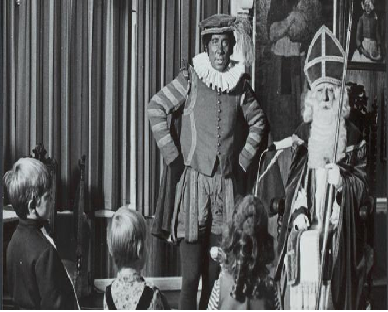Black Piet discussion of all times, evidenced by an exhibition at the Press Museum in Amsterdam. What has changed is the tone of the debate.

Images on a large screen TV Sesame Street in 1987. "It's every year the same song," says Gerda Havertong against Pino, "Santa Claus is not yet in the country, or black people, great people and children, are Zwarte Piet scolded. '
Images on a large screen TV Sesame Street in 1987. "It's every year the same song," says Gerda Havertong against Pino, "Santa Claus is not yet in the country, or black people, great people and children, are Zwarte Piet scolded. '
In the museum are photographs, images entrance, TV debates and see tweets. Black St. on an old Panorama cover 1987 and a white Peter, the front of a Playboy-trial issue of 1982 shows a white pin-up, their faces painted like Pete. Zwarte Piet is constantly changing, the message is, the discussion is certainly not 'suddenly a problem. "
Editor Jop Euwijk: "In the discussions sometimes you hear people saying: 'In the past, when the Netherlands was the Netherlands'. That makes no sense. Zwarte Piet is constantly readjusted. "
The exhibition also featured a first edition of the children's book St. Nicholas and his servant Jan Schenkman 1850 that Sints child for the first time as portrayed black. The figure not at all similar to how he looks now. So Piet always reflect the equally changing times. "In the fifties, it was really an ogre who could frighten children; later found people do not pedagogically sound. "
Euwijk cites a fragment of Van Kooten and De Bie 1989, which De Bie as H. van Galen talks about his long career as an important person, "moved up from assistant Piet Head important person ', and subtly take the resulting discussion about the color issue on the heel. "So you are real Black Petes' Van Galen said dejectedly," but they are certainly not better. Only the color though: too light. "
It also shows an excerpt from talk show Barend & Witteman 1997. "What is the problem if there are colored helpers?" Someone suggests, and creates chaos. Sonja Barend exclaims that she certainly made a hundred episodes, but it never rose as high.
The past two years, the debate really exploded. It has always been an emotional issue, but now the media really can not ignore, says Euwijk. "If the UN and the children's ombudsman to interfere with it, when people are arrested, then the media should though messages."
The social media are playing an important role, especially in keeping the launching of the discussion. "You can say that the media have made the matter more emotional," says Euwijk. "But they also have given people a voice that previously were not heard."
In a quote on the exhibition says the Amsterdam PvdA politician Henri Dors on the buck discussions in the NRC Handelsblad in 1990: "That we tackle well, that's a question a few years, holding it up." The recent emotional tweets hanging further prove the contrary. "So it keeps coming back," says Euwijk. "Then this historical dimension is not superfluous."
By Editors Volkskrant Photo: Joop van Bilsen, National Archives

Reactie plaatsen
Reacties